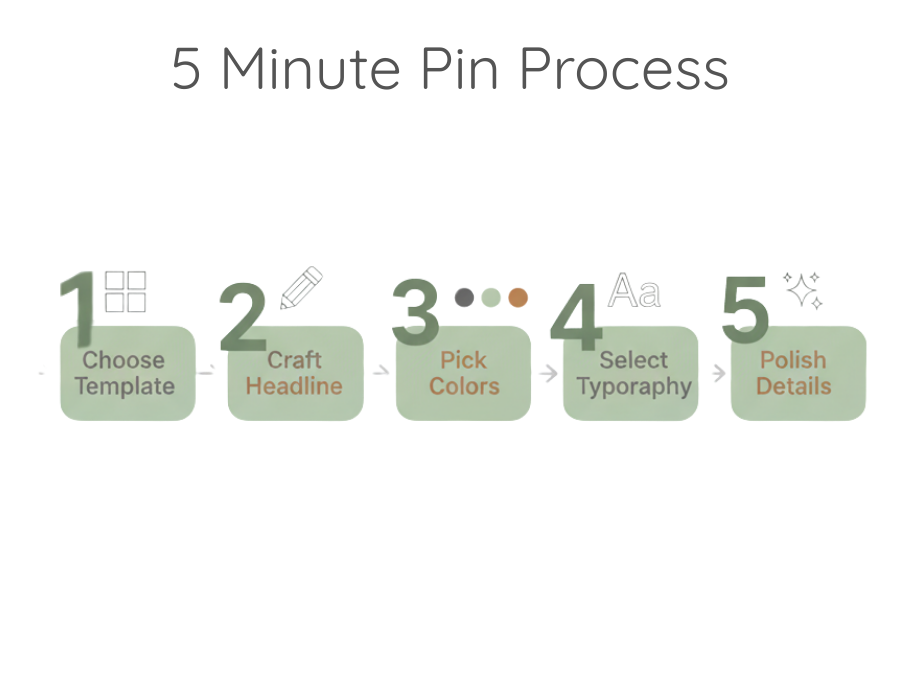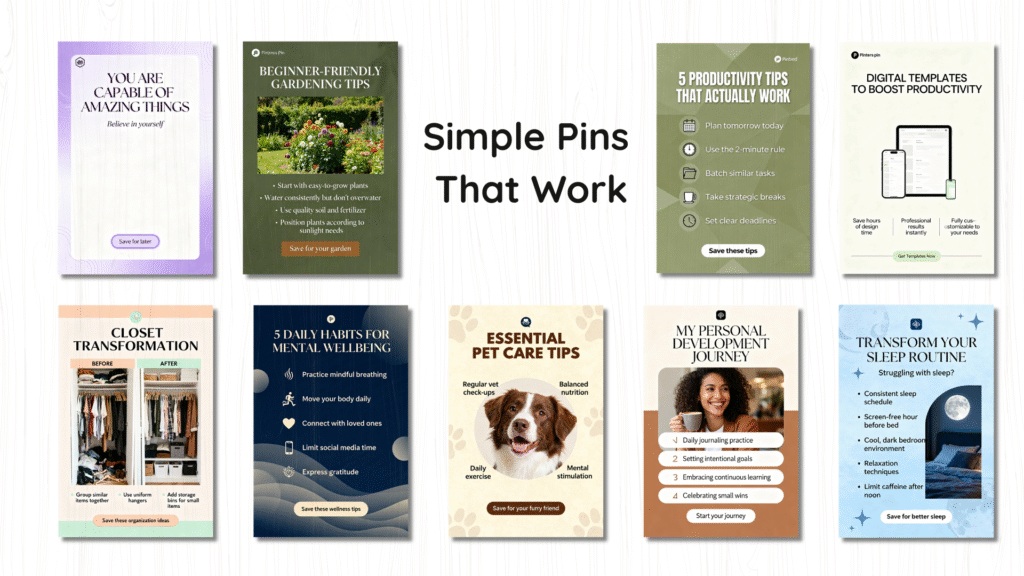I still remember the first Pinterest pin I ever created. I stared at that blank Canva canvas for what felt like hours, paralyzed by all the “rules” I thought I needed to follow. The fonts had to be perfect, the colors had to match some mysterious aesthetic I couldn’t quite define, and everything had to look like those impossibly polished pins that seemed to effortlessly rack up thousands of saves.
Three attempts and two minor breakdowns later, I published something that looked… fine. Not terrible, but definitely not the Pinterest-worthy masterpiece I’d envisioned. Sound familiar?
Here’s what I wish someone had told me that day: you don’t need to be a designer to create pins that connect with people. You just need to understand a few gentle principles and trust that your message matters more than perfect kerning.
Why “Good Enough” Is Actually Perfect
Before we dive into the how-to, can we talk about something? That voice in your head telling you that your designs aren’t “good enough” – she’s not serving you. I’ve watched too many brilliant business owners never hit publish because they’re waiting for their pins to look like they belong in a design museum.
The truth I’ve learned through creating thousands of pins (many of them wonderfully imperfect) is this: your audience isn’t looking for design awards. They’re looking for solutions, inspiration, and connection. A pin that clearly communicates value will always outperform a visually stunning pin with no substance.
That said, there’s absolutely nothing wrong with wanting your pins to look polished and professional. It’s just that the path there is simpler than you think.
The 5-Minute Framework That Changed Everything
After years of overcomplicating this process, I finally developed what I call the 5-Minute Pin method. It’s not about rushing – it’s about having a clear system that eliminates decision fatigue and gets you creating consistently.
Here’s how it works:
Minute 1: Choose Your Template Wisely
This might be the most important minute of the entire process. Instead of starting from scratch every time, build yourself a small collection of go-to templates. I keep about five different layouts saved in Canva, each optimized for different types of content.
My template collection includes a quote design, a list-style layout, a before-and-after format, a simple text-heavy design, and one with space for a product photo. That’s it. Having too many options will slow you down.
Choose templates with plenty of white space – it’s your friend, not your enemy. White space makes text easier to read and gives your design room to breathe. Some of my highest-performing pins are surprisingly simple, with just a compelling headline and minimal visual elements.
Minute 2: Craft Your Headline With Heart
Your headline is doing most of the heavy lifting, so let’s give it the attention it deserves. I’ve found that the most compelling pin headlines fall into a few categories that consistently resonate:
The Solution Promise: “How to [achieve desired result] without [common obstacle]” The Curiosity Hook: “The one [thing] that changed everything about [topic]” The Empathy Connection: “What to do when [relatable struggle]” The Gentle Challenge: “Why [common belief] might be holding you back”
Notice how none of these rely on superlatives or pressure tactics? Your audience is smart – they can spot manipulation from a mile away. Instead, focus on genuinely helpful language that acknowledges their reality.
When I’m struggling with a headline, I ask myself: “What would I tell my best friend about this topic over coffee?” That conversational tone often leads to the most authentic and compelling headlines.
Minute 3: Colors That Connect, Not Confuse
Color paralysis is real, and it’s stolen hours from well-meaning creators. Here’s permission to keep it simple: pick two or three colors maximum, and use them consistently across your pins.
You don’t need to reinvent the wheel with every design. In fact, consistency will serve you better than constant variety. Choose one main color that aligns with your brand (or just one you love), one neutral for text and background, and maybe one accent color for highlights.
Some of my most successful pins use just black text on a white background with a single pop of color. There’s something refreshing about simplicity in a world that’s constantly shouting for attention.
If you’re feeling overwhelmed by color choices, steal from nature. Sage green and cream, dusty rose and gray, ocean blue and sand – these combinations feel calm and inviting because they exist harmoniously in the world around us.
Minute 4: Typography That Tells Your Story
Typography is where I see most non-designers get tripped up, but it doesn’t have to be complicated. Stick with two fonts maximum – one for headlines and one for body text. And honestly? You could use just one font throughout and still create beautiful pins.
Look for fonts that feel like your brand personality. Are you approachable and warm? Try something with soft, rounded edges. More professional and structured? A clean sans-serif might be your friend. Playful and creative? You might gravitate toward something with a bit more personality.
The most important rule? Make sure it’s readable. If someone can’t easily read your text while quickly scrolling through Pinterest, all your other efforts are wasted. When in doubt, go bigger and bolder with your text.
Minute 5: The Magic is in the Details
This final minute is where good pins become great ones. It’s about those small touches that show you care about your audience’s experience.
Check your alignment – everything should look intentional and organized. Add a subtle shadow or border to make text pop against busy backgrounds. Make sure there’s enough contrast between your text and background colors.
But here’s the detail that matters most: save your pin with a descriptive filename. Something like “morning-routine-busy-moms.png” instead of “untitled-design-47.png.” Your future self will thank you when you’re looking for that perfect pin to reuse or reference.

What I Wish I’d Known Sooner
Looking back at my early Pinterest journey, I realize I was making it so much harder than it needed to be. I thought I had to master complex design principles and create something entirely original every single time. The pressure was exhausting.
The breakthrough came when I shifted my focus from perfection to connection. Instead of asking “Is this design award-worthy?” I started asking “Will this help someone?” That simple reframe changed everything.
I also wish I’d understood sooner that consistency beats perfection every time. My audience started recognizing my pins not because they were flawless, but because they had a consistent style and voice. They knew what to expect from me, and that familiarity bred trust.
Your Next Five Minutes
Right now, you might be thinking, “This sounds great in theory, but what about my specific situation?” Maybe you’re in a creative field and feel extra pressure to have “good design.” Perhaps you’re in a more traditional industry and worry that simple designs won’t convey professionalism.
Here’s what I’ve learned: your audience cares more about value than visual complexity. A clear, simple pin that solves a problem will always outperform a cluttered, “designed-looking” pin that confuses the viewer.
Start with one template. Create one pin using the 5-minute method. Don’t overthink it, don’t perfect it to death, just create it and share it. Then do it again tomorrow.
The magic isn’t in having perfect design skills – it’s in showing up consistently with helpful content that connects with real people facing real challenges.
Moving Forward With Gentle Confidence

Creating pins doesn’t have to be another source of stress in your already full life. It can actually become a few minutes of creative calm in your day, a chance to distill your wisdom into something visually appealing that serves your community.
Remember, every designer you admire started exactly where you are now. They just kept creating, learning from what worked and what didn’t, and gradually developed their eye and skills. You’re not behind – you’re just beginning.
Your voice matters. Your perspective is valuable. And your willingness to share what you’ve learned through simple, honest design is exactly what Pinterest needs more of.
So grab those five minutes. Pick a template, write a headline that would help a friend, choose colors that feel like you, and create something real. The world is waiting for what you have to offer – imperfections and all.
The most beautiful thing about the 5-minute pin? It’s not about the five minutes at all. It’s about giving yourself permission to create without perfection, to help without having all the answers, and to show up authentically in a space that often rewards the loudest voice.
Your quiet confidence and genuine desire to help? That’s your secret weapon. Use it.
